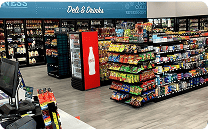In This article
Inventory reconciliation is a key practice in maintaining the accuracy and integrity of a company’s inventory management system. It involves comparing the quantity of items on hand with the amounts recorded in accounting or inventory tracking software. Any discrepancies between the two data sets are identified, investigated, and corrected to ensure the business accurately understands its inventory position.
Key Steps for Inventory Reconciliation
Accurate inventory records are essential for day-to-day operations, financial reporting, purchasing decisions, customer satisfaction, and loss prevention efforts. Without regular reconciliation, businesses risk operating based on incorrect assumptions, leading to stockouts, overordering, margin erosion, and compliance issues.
The reconciliation process typically involves several steps:
- Physical Count: Conducting a manual count of items in stock, often through complete counts, cycle counts, or spot checks.
- Data Comparison: Comparing physical count results against the inventory records stored in the system.
- Discrepancy Identification: Highlighting items whose recorded quantity does not match the actual amount.
- Root Cause Analysis: Investigating why discrepancies occurred, such as theft, administrative errors, mislabeling, supplier shortfalls, or damage.
- Adjustment and Reporting: Correct the inventory system as needed and document the findings for future reference and audits.
Causes of Inventory Reconciliation Discrepancies
In businesses that handle high volumes of inventory, such as retail stores, restaurants, warehouses, and logistics centers, reconciliation is often supported by advanced technology like barcode scanners, inventory management software, and surveillance footage tied to receiving and stocking areas. This technological support reassures businesses and instills confidence in the accuracy of their inventory management.
Common causes of inventory discrepancies include:
- Employee theft or customer shoplifting.
- Supplier errors during delivery.
- Miscounts during receiving or stocking processes.
- Administrative mistakes in recording sales, returns, or adjustments.
- Damage, spoilage, or expiration of perishable goods.
Why Inventory Reconciliation is Essential
By systematically reconciling inventory, businesses can uncover these issues early and implement corrective measures to minimize financial loss and operational disruption.
Inventory reconciliation is also essential for:
- Accurate financial reporting is especially important for businesses that rely on inventory valuation for balance sheets and tax reporting.
- Effective supply chain management ensures that reorders are based on accurate stock levels.
- Loss prevention efforts help identify patterns of shrinkage or theft.
- Customer satisfaction, by reducing out-of-stock situations and maintaining fulfillment reliability.
Businesses often perform complete inventory reconciliations quarterly or annually. However, many also use cycle counting—a process of regularly counting a subset of inventory items—to maintain continuous accuracy without the need for large, disruptive counts. This approach provides a sense of security and control over the accuracy of inventory records.
Inventory reconciliation becomes even more effective when paired with surveillance and transaction data. Video review can help verify discrepancies during deliveries, customer transactions, or staff handling, providing visual evidence that supports faster investigations and more informed decision-making.
Regular, well-executed inventory reconciliation supports operational efficiency, protects profit margins, and builds confidence across finance, operations, and management teams.
Strengthen Inventory Accuracy with DTiQ
DTiQ’s 360iQ platform helps QSR, C-store, and retail companies connect inventory reconciliation efforts with real-time surveillance, transaction data, and operational insights. Whether verifying delivery processes, monitoring sales floor activity, or investigating stock discrepancies, DTiQ provides the tools and visibility needed to maintain tighter control over your inventory and protect your bottom line. Want to see more? Schedule a demo.





























